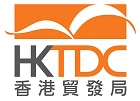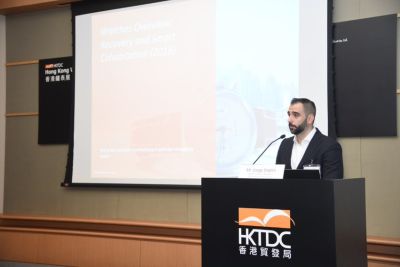|
| Friday, 6 September 2019, 17:00 HKT/SGT | |
| |  | |
Source: HKTDC | |
|
|
|
|
| Smart wearable trends in focus at HKTDC Hong Kong Watch & Clock Fair seminar |
HONG KONG, Sept 6, 2019 - (ACN Newswire) - Industry experts came together at the Asian Watch Conference, themed "Get Connected: Smart Techs for Smart Watches", on Wednesday (4 September) to explore digitisation trends and opportunities in the mobile Internet era, with a specific focus on smart watches and hybrid watches. The conference took place on the second day of the 38th HKTDC Hong Kong Watch & Clock Fair, which runs at the Hong Kong Convention and Exhibition Centre from 3 to 7 September.
 | | Jorge Martin, Head of Fashion Research at Euromonitor International, examined trends in the global watch industry at the Asian Watch Conference, held as part of the 38th HKTDC Hong Kong Watch & Clock Fair. |
Digitisation and connectivity trends
Drawing on the vast global market research resources of Euromonitor, Jorge Martin, Head of Fashion Research at Euromonitor International, discussed three issues: digitisation trends and balance, relevant connectivity, and analogue reinvention.
Mr Martin pointed out that 4 billion people around the world now use the Internet, up from 2 billion just a decade ago, and that 41% of these users access the Internet daily. Of particular note is what he calls "digitisation democratisation" - the fact that half of connected users are now from emerging economies, whereas 10 years ago it was mainly people in developed markets that used the Internet. Other recent developments include the change in lifestyles in the connected world; until recently, people mainly used the Internet for communication, but now everything can be connected - from homes and cars to traffic lights.
These changes have helped empower consumers, according to Mr Martin, making them the centre of the digitised world. But there is a downside to these enormous changes. It has resulted in passive consumption, as businesses use big data and artificial intelligence to predict what consumers need. And it has resulted in a "digital detox" for many people. For example, according to Euromonitor research, 25% of consumers say passive access to the Internet adds stress to their lives. As a result, big companies like Apple, Google and Facebook are enabling users to actively manage their online access.
Other issues are whether the connected device is relevant, in terms of addressing unmet consumer needs or adding extra value to the consumer experience; whether it does the job it was designed to do; and whether it is user-friendly, in terms of allowing effortless interactivity, for example.
Mr Martin discussed the ever-changing positioning in the smart wearables ecosystem, as sportswear manufacturers such as Nike - to give one example - enter the smart-tracking market. "Differentiation allows product cohabitation," he said. Traditional timepieces offer the time function, while the others are mainly fashion-oriented.
Mr Martin pointed out that traditional watch players have seen a recovery in the market, while those aggressively pursuing smart watches have seen sales fall recently. Brands such as Swatch, Rolex, Omega and Casio, for example, have all seen a recovery, while hybrid sales have been declining.
Mr Martin discussed the issue of "analogue reinvention". Aware of the power of digitisation and connectivity, analogue watch manufacturers and retailers have been trying creative approaches, he said. One example is slow watches, which use a 24-hour dial. This is in-sync with the "slow movement", while minimalistic designs are also proving popular these days, he explained. Instead of pushing people to always be connected, watch manufacturers are taking the opposite approach - going back to the basics. One example is Crown and Caliber, a company that sells pre-owned premium watches online, and tests and guarantees them to reassure buyers. Another example is Schaffen Watches, a small brand that allows consumers to co-design their own personalised watch.
Mr Martin concluded that while we are seeing exponential growth in digitalisation, consumers seek "digital balance", and that there is a need to avoid redundant connectivity. "Through analogue creativity, there are a lot of things that can be done with traditional timepieces," he said.
The keys to IT supremacy
Emil Chan, Chairman of the Association of Cloud and Mobile Computing Professionals, discussed the past, present and future of the connected mobile Internet era, opening with the analogy of Hong Kong as the original connector between Mainland China and the rest of the world, and how this role changed as Hong Kong developed world-class infrastructure, along with its watch and clock, banking, finance and trading industries. But Hong Kong has fallen behind in certain industries, such as cargo handling, with mainland ports using advanced technologies to leapfrog the city, he said.
The keys to information technology (IT) supremacy, Mr Chan maintained, are big data and blockchain technology. The former is vital because artificial intelligence depends on massive amounts of data to be useful, while the latter involves data compilation, database applications, transaction processing, business intelligence and global applications. "Data is the new oil," he explained. "With blockchain, we can do everything, anytime and anywhere, but we can't do anything without data."
Like Singapore, London and New York, which control oil trading without producing any oil, Hong Kong can be a major player in the data storage industry, Mr Chan argued, even though it produces relatively little data. Data storage is important for Hong Kong's future, he said. In the future, all data will be stored on blockchain, which will open up a new world of possibilities.
Mr Chan also talked about the future of 5G. It is more than just faster speed, he pointed out. It will allow cars to communicate with each other, for example, resulting in safer roads. If watches can talk to each other, phones will no longer be needed and everyone will know where all their contacts are. The 5G landscape will result in a 10-fold decrease in latency and 10-times greater connection density, he explained. Among the other benefits of 5G, he mentioned electronic IDs, more accurate credit scores, and more reliable biometric information.
"We have to think digitally for Hong Kong's future," Mr Chan concluded.
Trends and opportunities for smart wearables
Philip Wong, Vice-President (Technical) at the Movado Group, provided an update on smart watches and discussed what's next for watches in the connected era. He said the past two to three years had seen an increase in connected watches for children aged four to 12 and for the elderly, according to research professionals. There has also been a rise in the number of hybrid smart watches sold.
He reviewed the preferred functions of smart watches for children, including real-time location monitoring, SOS alerts, proximity break alerts, location history, school attendance tracking, and geofence-enabling as a safeguard. As an example of the future for this segment, Mr Wong pointed out that Qualcomm, one of the biggest chipset providers in the world, has developed a chipset for kids' smart watches that it uses in its own products, selling 25 million units in 2017. He concluded that smart watches for children would form a big part of the IOT smart wearables market.
Mr Wong also discussed the relative merits of traditional watches versus hybrids. Recent market research found that high-income consumers were more interested in hybrid smart watches than smart connected watches, he said, presenting a market opportunity for hybrid smart watches. This is resulting in a fusion between traditional analogue watches and smart connected features using Bluetooth Low Energy (BLE) connectivity. These watches do not have as many functions as regular smart watches, but have a much longer battery life and "real" dials, with watch hands. They generally have basic functions, such as an activity tracker, for health management, a notification function, automatic time-zone synchronisation and remote control. Market research shows that consumers also want an ECG measurement tracker that can provide useful information for their doctor. "The new hybrids are aligned with the expectations and needs of upper-income consumers - simple and adequate," he said.
An additional benefit of hybrid watches, Mr Wong pointed out, is that the investment cost is lower, although they do have additional costs in terms of software development, certification and licensing, and app maintenance. The lower entry cost will encourage greater participation in this watch category, he concluded.
Fair websites
- HKTDC Hong Kong Watch & Clock Fair: https://hkwatchfair.hktdc.com
3-7 September: Trade visitors aged 18 or above only (free admission)
- Salon de TE: https://hkwatchfair.hktdc.com/te
7 September: Open to public visitors aged 12 or above (free admission)
Photo download: https://bit.ly/2k31bmm
Contact:
Sunny Ng, Tel: +852 2584 4357, Email: sunny.sl.ng@hktdc.org
Topic: Trade Show or Conference
Source: HKTDC
Sectors: Watches & Jewelry
https://www.acnnewswire.com
From the Asia Corporate News Network
Copyright © 2025 ACN Newswire. All rights reserved. A division of Asia Corporate News Network.
|
|
|
|

|
|
|
|